Acer Nitro 5 review (AN517-51 17-inch model – i7-9750H, GTX 1660Ti)
Nitros are Acer’s entry-level gaming laptops, devices meant to offer excellent specs and value for not a lot of money.
In this article, we’re covering the 2019-edition of the Nitro 5 series, the 17-inch AN517-51 version. There’s also a 15-inch Nitro 5 AN515-54 model, which we’ll touch in another dedicated review.
Unlike the Nitros of the past, this update is a little different, with a more compact and sturdier build, a slightly cleaner design and the features buyers would expect in a capable 2019 gaming device, even when shopping on a budget: a 144 Hz IPS screen, the latest hardware specs, with a 9th gen Core i7 processor and the Turing GTX 1660 Ti GPU on our test model, as well as a larger battery than on the previous generation.
We’ve spent about two weeks with an early production model of the 17-inch Acer Nitro 5, and gathered all our impressions below, with the strong points and the quirks you should be aware of before buying one of these.
Mục Lục
Specs as reviewed
Acer Nitro 5 AN517-51
Display
17.3-inch, 1920 x 1080 px IPS 144 Hz, non-touch, matte, Chi Mei N173HCE-G33 panel
Processor
Intel Coffee Lake Core i7-9750H CPU, six-core
Video
Intel HD 630 + Nivida GTX 1660Ti 8 GB GDDR5 (GeForce 430.86), with Optimus
Memory
16 GB DDR4 2666 MHz (2x DIMMs)
Storage
2x M.2 PCI x4 slots, with RAID 0 support (2x 512 GB WDC PC SN520)
+ 2.5″ bay (1 TB WD Blue WD10SPZX)
Connectivity
Gigabit LAN (Killer E2500), Wireless AC 1×1 (Intel 9560), Bluetooth 5.0
Ports
2 x USB-A 3.1, 1x USB-A 2.0, 1x USB-C, HDMI 2.0, LAN, mic/headphone, Kensington Lock
Battery
58 Wh, 180 W charger
Size
405 mm or 15.9” (w) x 286 mm or 11.25” (d) x 27.9 mm or 1.1” (h)
Weight
6.05 lbs (2.74 kg), 1.52 lbs (.69 kg ) for charger and cables, EU version
Extras
red backlit keyboard, 720p webcam, stereo speakers
Acer offers this line in a bunch of different configurations, with Core i5 and i7 processors, Nvidia GTX 1650 or 1660 Ti graphics, various amounts of memory and storage, as well as either a 60 Hz or a 144 Hz IPS panel. You shouldn’t look past the i5/GTX 1650 models if you’re shopping on a very low budget, but I would make sure to get dual-channel memory, SSD storage, and the 144 Hz screen, especially if you’re into fast-action games.
Design and construction
As of 2019, Acer offers both a Nitro 5 and a Nitro 7 series. The former is the base-level version in the lineup, with a plastic case, while the latter is the upgraded variant with a complete metallic build and cleaner aesthetics, with fewer flashy red elements.
Even so, this 2019 Nitro 5 is definitely a step-up from the previous model. Yes, it’s still entirely made out of plastic, and yes, there are still some red accents on the inside and outside, but the footprint is much smaller now and the overall build-quality is significantly studier. There’s very little flex in the main chassis and the lid, and the plastic used for the interior doesn’t show smudges as easily as other black materials, so you’re going to have an easier time keeping this neat.
As for the overall size, this 17-inch Nitro is not as portable as some of the other higher-tier 17-inchers on the market, but it gets fairly small bezels and an overall weight of 6 lbs, so you’re not going to struggle with it in your backpack. There’s also that power brick to consider though, with the 180W version on this configuration weighing an extra 1.5 pounds, but if you opt for the i5/GTX 1650 models you’ll get a smaller and lighter 135W brick instead.
The design still leaves a sharp front edge and pointy corners though, just like on the Nitro 5, which can bite into your wrists when using the laptop on a cramped desk, without ample arm support. That aside, this laptop is practical and smartly put together.
The screen is held in place by two strong hinges that allow it to lean back to about 165 degrees, as well as allow to open it up and adjust the angle with a single hand. The status LEDs have been moved to the sides, so there’s no pesky light to bother you when watching a movie in the dark, once the keyboard turns off. Flipping the laptop upside down you’ll notice that large rubber feet are placed on the belly, keeping the whole thing tightly anchored on a flat surface, as well the ample air intake grills and the small, tiny, speaker cuts, which hint at some tinny speakers inside (we’ll get to that further down in this article).
The IO is pretty good as well, with several USB-A slots, a USB-C connector, LAN and HDMI. There’s no support for Thunderbolt 3 and no card-reader, and it’s also worth mentioning that the power plug and the headphone jack are inconveniently placed on the front half of the right side, which can interfere with your mouse.
All in all, while there’s no doubt this is merely an entry-level gaming laptop, there’s very little to complain about the Nitro 5’s build and design, and only a few nits when analyzing its practicality. For what is worth, though, the standard has gone up significantly in this section of budget-friendly devices, and while a hefty upgrade from the previous Nitro 5s, this 2019 model is still just about on par with competitors like the Asus TUF FX705, HP Pavilion Gaming 17, Asus TUF Gaming FX705 or the Lenovo Legion Y540 17.
Keyboard and trackpad
On a first look, the keyboard hasn’t changed much from the previous Nitro 5 lineups, but you’ll see that it feels a little friendlier once you get to use it.
The layout is standard and due to cost-cutting measures, identical to the 15-inch models, with a main set of properly spaced and sized 15 x 15 mm keys and a smaller NumPad Section at its side, with full-size arrow keys this time around, a slight separation between the Numpad section and the rest of the keys, as well as the Power button still implemented as the top-right key. Unlike other OEMs, though, Acer automatically disables this in Windows, so you’re not going to put the computer to sleep if you’ll accidentally press it.
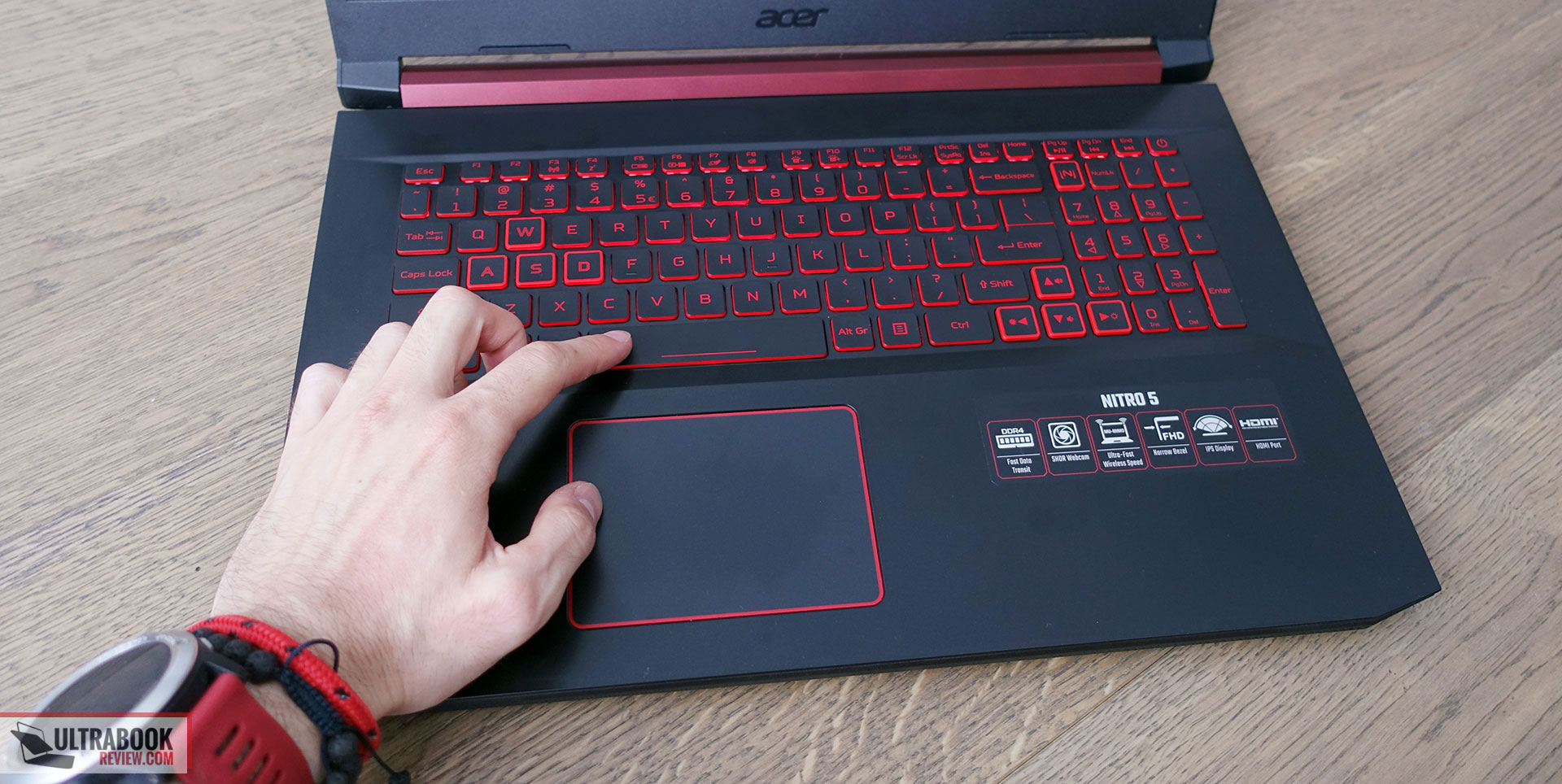
The Nitro 5 still gets a Black and Red themed keyboard, with emphasized arrows and WASD keys. The keys are backlit, with bright red LEDs beneath each keycap and three intensity levels to choose from. The illumination is still not completely even and light creeps from beneath some of the keys, as they’re fairly tall, but I doubt that’s something most will even notice. The lack of actual indicators for CapsLock or NumLock, on the other hand, that can get frustrating at times, as well as the fact that the illumination cannot be activated by swiping your fingers over the clickpad, you actually have to hit a key for it.
As for how this keyboard types, well, it’s a pretty good implementation, with softly coated keys, good travel, and firm feedback. Just like on the Nitro 7 I’ve tested earlier, I found the keys a bit too stiff for my typing style, which took a toll on my accuracy, but if you’re coming from an older laptop or a desktop keyboard, you’ll most likely get used to this keyboard in a very short time.
The clickpad hasn’t changed from the old Nitros, either. It’s averagely sized and it’s a plastic surface with Elan hardware and Precision drivers, thus handles everyday use smoothly and reliably. The physical clicks are bit stiff, yet quiet, and the surface still rattles when tapped firmer, unlike on the sturdier Nitro 7 variant.
As for biometrics, there are none on this laptop.
Screen
Acer offers this 17-inch Nitro 5 AN517-51 with either a 60 Hz or a 144 Hz screen, and we got the latter on our test unit, which is definitely the smarter option in a gaming laptop. Lower end configurations might be paired with the standard 60 Hz screen, which is still alright for daily use, but slower, thus ghosting and tearing will occur with fast games, so I’d advise you to aim for this 144 Hz variant as much as possible.
Acer went with the capable Chi Mei CMN175C (N173HCE-G33) panel on our test model, the same you’ll normally find on higher tier devices like the Acer Predator Helios 300 or the MSI GS75 Stealth.
For some reason we weren’t able to install our calibration software on this sample, so cannot offer the standard screen readings, but you should head over to the Helios 300 review for more details.
In a few words, though, expect brightness levels of 300+ nits, contrast of 900:1, 77% coverage of AdobeRGB and an evenly lit panel, without light bleeding. This is also one of the faster 17-inch panels on the market, with 10 ms GTG response time, and while it uses PWM for the lowest brightness levels (< 25%), the high 25 KHz frequency ensures that even the most flicker-sensitive among you won’t notice it on this panel.
Hardware and performance
Out test versions is a mid-tier configuration of the Acer Nitro 5 AN517-51, with the Core i7-9750H Coffee Lake processor, 16 GB of dual-channel 2666 MHz RAM, dual graphics and triple-storage.
It gets two M.2 SSDs hooked up in RAID0, as well as a HDD for storage, while the Intel HD 630 iGPU integrated within the Core i7 processor is supplemented by an Nvidia GTX 1660Ti 6GB dGPU.
The 1660Ti is Nvidia’s mid-range budget friendly Turing chip as of 2019, and a direct follow-up for the Pascal GTX 1060s, but performance wise it sits somewhere close to GTX 1070 levels and within 10% of the RTX 2060 Turing variants, as you’ll see below. Acer also offers the Nitro 5 with the more basic GTX 1650 Ti graphics, as you can see how the 1650 and 1660Ti compare from this article, as well as from this review of the GTX 1650 equipped Nitro 7 variant.
The CPU and GPU are soldered onto the motherboard, but the RAM, storage and the WiFi module are accessible. To get to them you’ll have to remove the back panel, hold in place by a handful of Philips screws, which is a fairly simple task and gives unobstructed access to all those components, as well as the cooling solution, battery, and speakers.
Before we proceed to talk about the performance, you should know that our review unit is a pre-production model, but with the latest drivers from Nvidia (version 430.86) available at the time of the article, so while you should take our findings with a grain of salt, I wouldn’t expect any significant changes on the retail versions you’ll find in stores.
The Nitro 5 is primarily an all-around computer meant for everyday use, work and gaming, so it will have to deal with mundane activities often, not just the more demanding tasks. Our sample handled these daily tasks smoothly (browsing, Netflix, Youtube, text-editing), as you’ll find from the logs below, running cool and quiet, and although the fans don’t switch off with basic activities, you’ll only hear them in very quiet environments,
On to more demanding tasks, we’ll start by testing the CPU’s performance in 100% loads, and we do that by running Cinebench R15 for 10+ times in a loop, with 2-3 seconds delay between each run, with the laptop on the Maximum Performance Power profile in the Nitro Sense app and out-of-the-box settings. Most implementations of the i7-9750H CPU return high-scores for the first Cinebench runs, and then settle a little lower as the CPU heats-up and can no longer maintain its maximum Turbo speeds for more than a few seconds.
This one performed just as expected, and settled for speeds of 2.8+ GHz, a TDP of 45 W and temperatures of around 75 degrees Celsius, as well as scores of 950+ points. Details below.
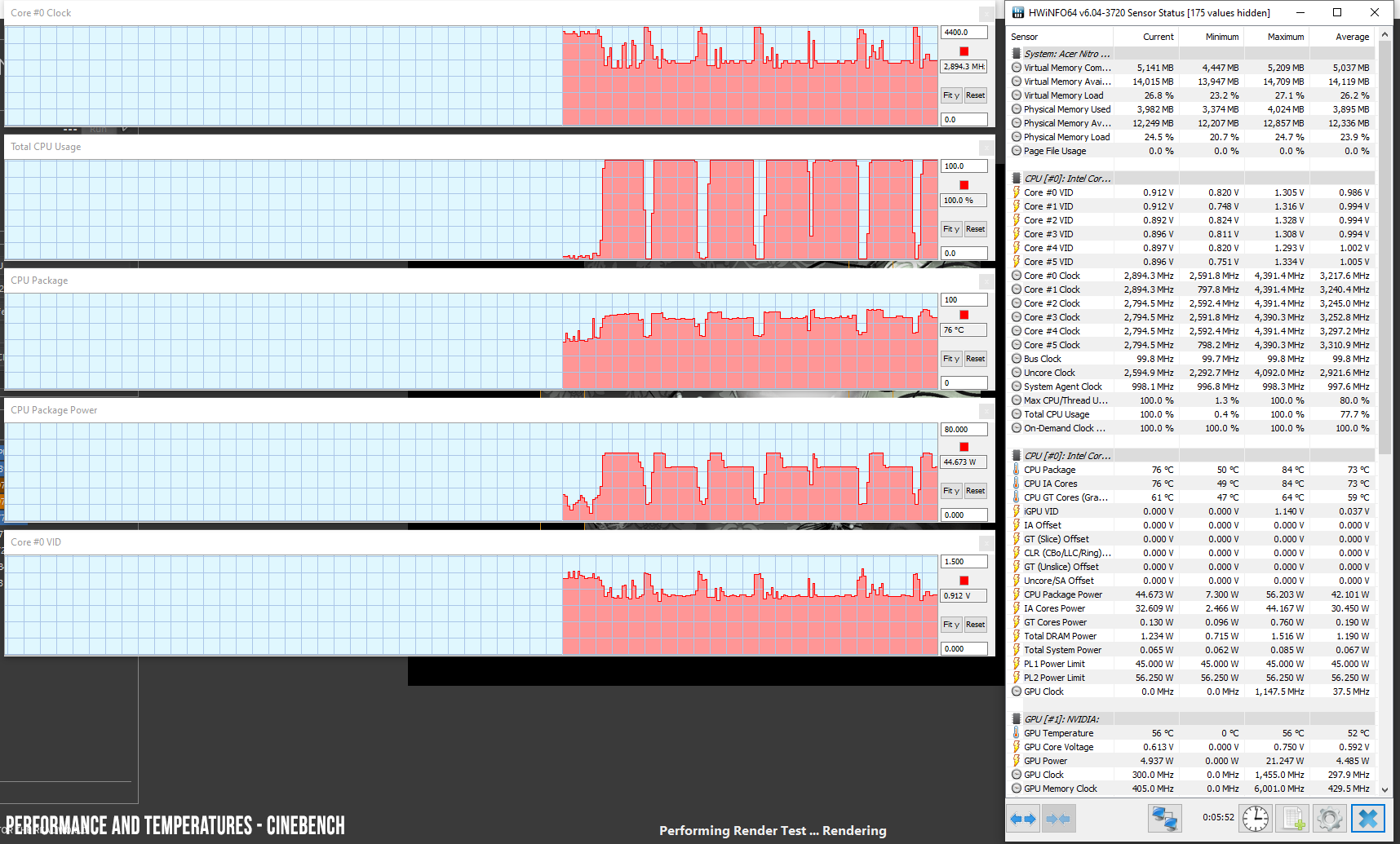
These are fairly low frequencies and scores for the 45W TDP, and Power Limit Throttling is the limiting factor, but the behavior can be further addressed with undervolting, and our test unit ended up stable in benchmarks and real-use at -150 mV.
In this case, the CPU settled for scores of 1100+ points, Turbo Boost speeds of 3.3+ GHz, a TDP of 45 W and similar temperatures of 75 degrees Celsius. Details below.
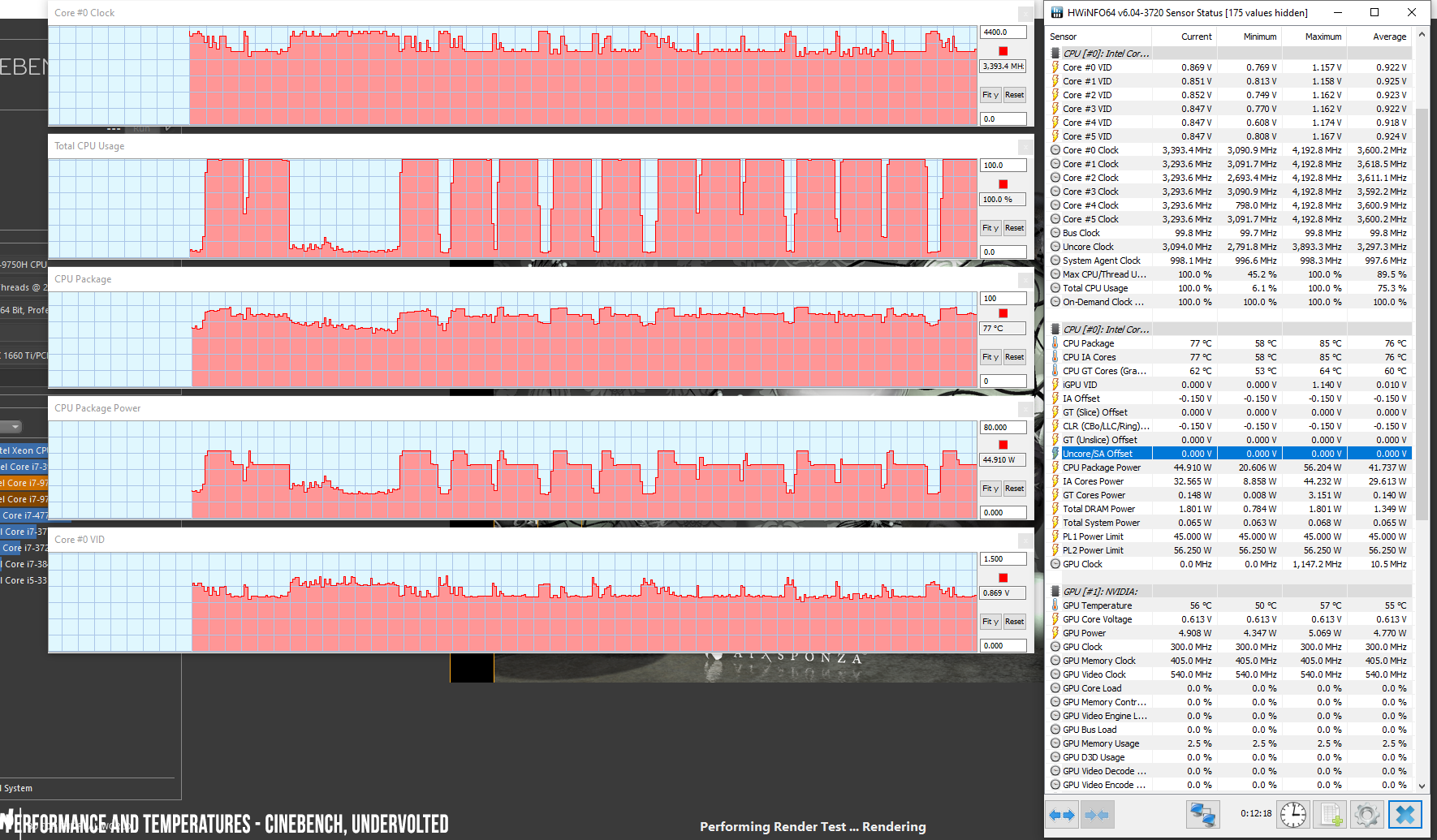
Power Limit Throttling is the limiting factor here, and XTU did not allow us to further up the TDP limit, so that leaves or Nitro 5 sample at roughly 85-90% of what the 9th gen i7 processor is capable of delivering in a best-case implementation. Thermally, there’s a hefty headroom that could allow Acer to further improve the performance if they decide to up the Power Limit in a future BIOS update, but I wouldn’t hold my breath for it.
Despite this behavior in the Cinebench loop test, the CPU actually runs well with games and benchmarks once undervolted, as you’ll see below, but out-of-the-box it does struggle with certain demanding loads.
We first ran our set of standard benchmarks on the default Max Performance profile with out-of-the-box settings, and here’s what we got:
- 3DMark 11: P16041 (Graphics: 19482, Physics: 10500);
- 3DMark 13 – Fire Strike: 12608 (Graphics – 14535, Physics – 13111);
- 3DMark 13 – Time Spy: 5614 (Graphics – 5641, CPU – 5466);
- Uniengine Superposition Extreme: 3116;
- GeekBench 4.1.1 64-bit: Single-Core: 5465, Multi-core: 21306;
- CineBench R15 (best run): CPU 954 cb, CPU Single Core 175 cb;
- CineBench R20 (best run): 2072;
- x264 HD Benchmark 4.0 32-bit: Pass 1 – 202.45 fps, Pass 2 – 63.84 fps.
Next, we also ran some of the tests on what we call a Tweaked profile, with the CPU undervolted at -150 mV and the GPU overclocked at + 200 MHz Core, + 1000 MHz memory in the Asus GPU tweak II utility.
- 3DMark 11: P17811 (Graphics: 21513, Physics: 11498);
- 3DMark 13 – Fire Strike: 13931 (Graphics – 15885, Physics – 14942);
- 3DMark 13 – Time Spy: 6060 (Graphics – 6048, CPU – 6131);
- Uniengine Superposition Extreme: 3360;
- PCMark 10: 5485 (Essentials – 9265, Productivity – 7613, Digital Content Creation – 6348);
- PassMark: Rating:6442, CPU mark: 13748, 3D Graphics Mark: 10089;
- GeekBench 4 64-bit: Single-Core: 5241, Multi-core: 22351;
- CineBench R15: CPU 1165 cb, CPU Single Core 172 cb;
- CineBench R20 (best run): 2392;
- x264 HD Benchmark 4.0 32-bit: Pass 1 – 214.98 fps, Pass 2 – 66.62 fps.
Keep in mind that our configuration comes with a fast SSD Raid0 storage array, and that impacts some of the results, like PCMark and PassMark.
The Tweaked profile leads to 7-12% gains in CPU scores, due to undervolting, but even so, some of the more demanding chores like Cinebench and X264bench cannot match the platform’s maximum potential. The GPU scores also increase by 5-7%, due to the +200 MHz frequency boost, which applies to both Base and Turbo clock speeds, but the performance is Power throttled and cannot benefit from the full potential of this increase.
It’s also important to add that the Tweaked profile also leads to a small drop in CPU and GPU temperatures in demanding loads, as you can see in the following 3DMark logs, as well as down below, in the gaming performance section. Even so, the CPU/GPU ran unusually hot with this test on this sample, at around 90 degrees Celsius each, so I’d expect improved thermals from the retail versions, as well as potentially improved performance.
With that out of the way, let’s look at some gaming results. We ran a couple of games representative for DX11 and DX12 architectures, both on the Standard and the Tweaked profiles:
- FHD Default – Max Performance in Nitro Sense, fans on Auto, default settings;
- FHD Tweaked – Max Performance in Nitro Sense, -150 mV CPU undervolt, fans on Auto with CoolBoost ON, GPU overclock with GPU Tweak II: + 200 MHz Core, + 1000 MHz memory.
The Auto fan profile quickly ramped the fans up to maximum levels with games, and then tamed them down with daily use. That’s satisfactory behavior, although better fan control with the ability to set a fan curve based on temperature brackets would be welcomed. Opting for CoolBoost didn’t seem to have an impact on this test sample, but it should on the retail versions, based on our experience with other Acer laptops in the past.
Anyway, here’s what we got in games:
FHD Default
FHD Tweaked
Battlefield V (DX 12, Ultra Preset, Ray-Tracing OFF)
74-88 fps
82-94 fps
Far Cry 5 (DX 11, Ultra Preset, SMAA)
83 fps
86 fps
Middle Earth: Shadow of Mordor (DX 11, Ultra Preset)
144 fps
156 fps
Rise of Tomb Raider (DX 12, Very High Preset, FXAA)
82 fps
82 fps
Shadow of Tomb Raider (DX 12, Highest Preset, TAA)
68 fps
75 fps
The Witcher 3: Wild Hunt (DX 11, Ultra Preset, Hairworks On 4)
54-78 fps
56-84 fps
- Battlefield V, The Witcher 3 – recorded with Fraps/in-game FPS counter in campaign mode;
- Far Cry 5, Middle Earth, Tomb Raider games – recorded with the included Benchmark utilities.
The HWinfo logs below show the CPU and GPU speeds and temperatures in Farcry 5, Battlefield V and Witcher 3 on the Default profile, with the fans on Auto, which keeps them running at 6000+ rpm and noise levels of 52-53 dB at head level on our review unit.
Switching to the Undervolted CPU profile, without tweaking the GPU, leads to a significant drop in CPU/GPU temperates and a slight increase in GPU speeds.
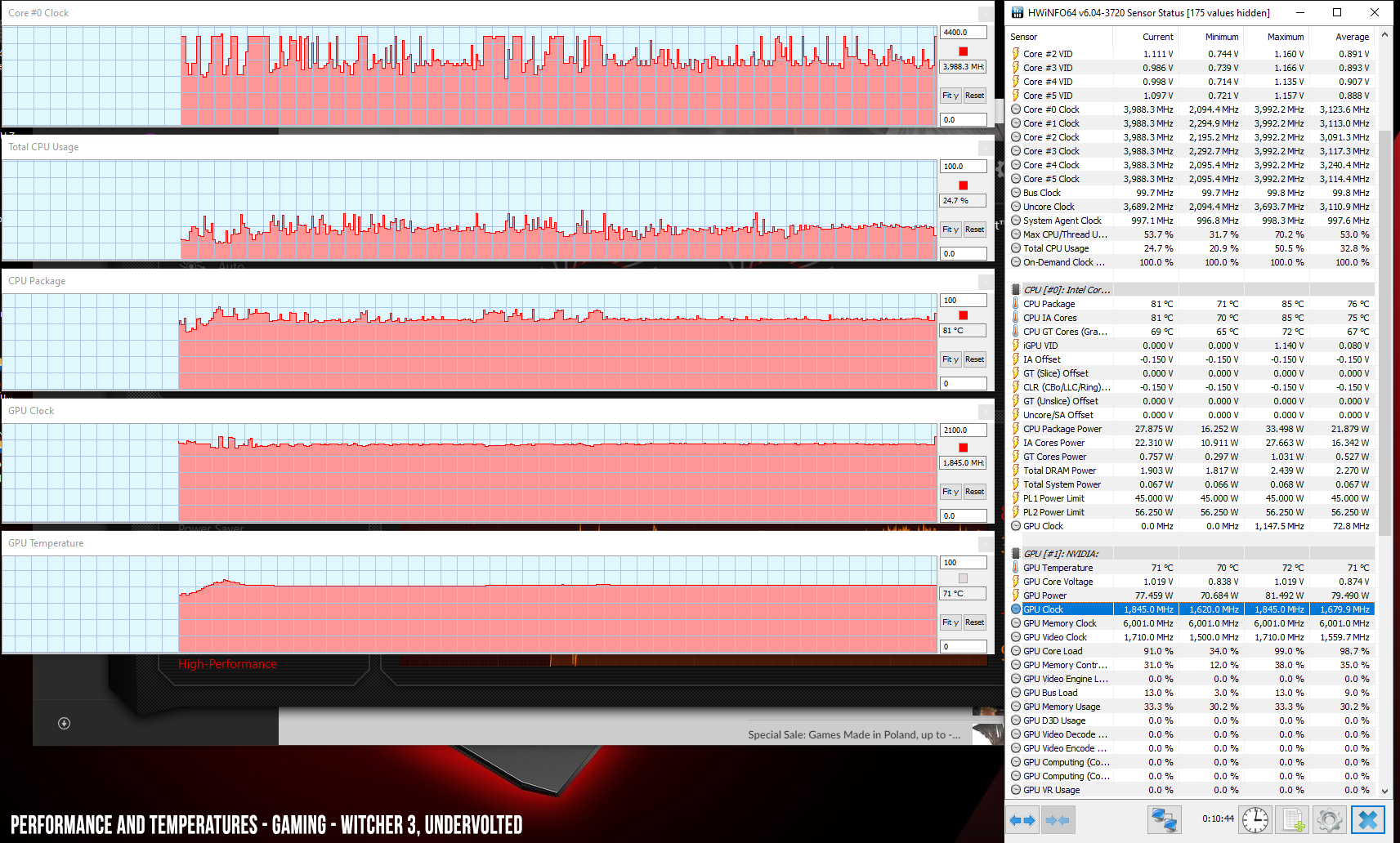
Switching to the Tweaked profile, with the undervolted CPU and overclocked GPU, leads to further gains in GPU performance.
Lastly, unplugging the laptop limits the CPU and GPU’s performance, but most games are still playable in this case, as the CPU still averages 3.5 GHz and the GPU 1.68 GHz, something most other laptops cannot rival on battery.
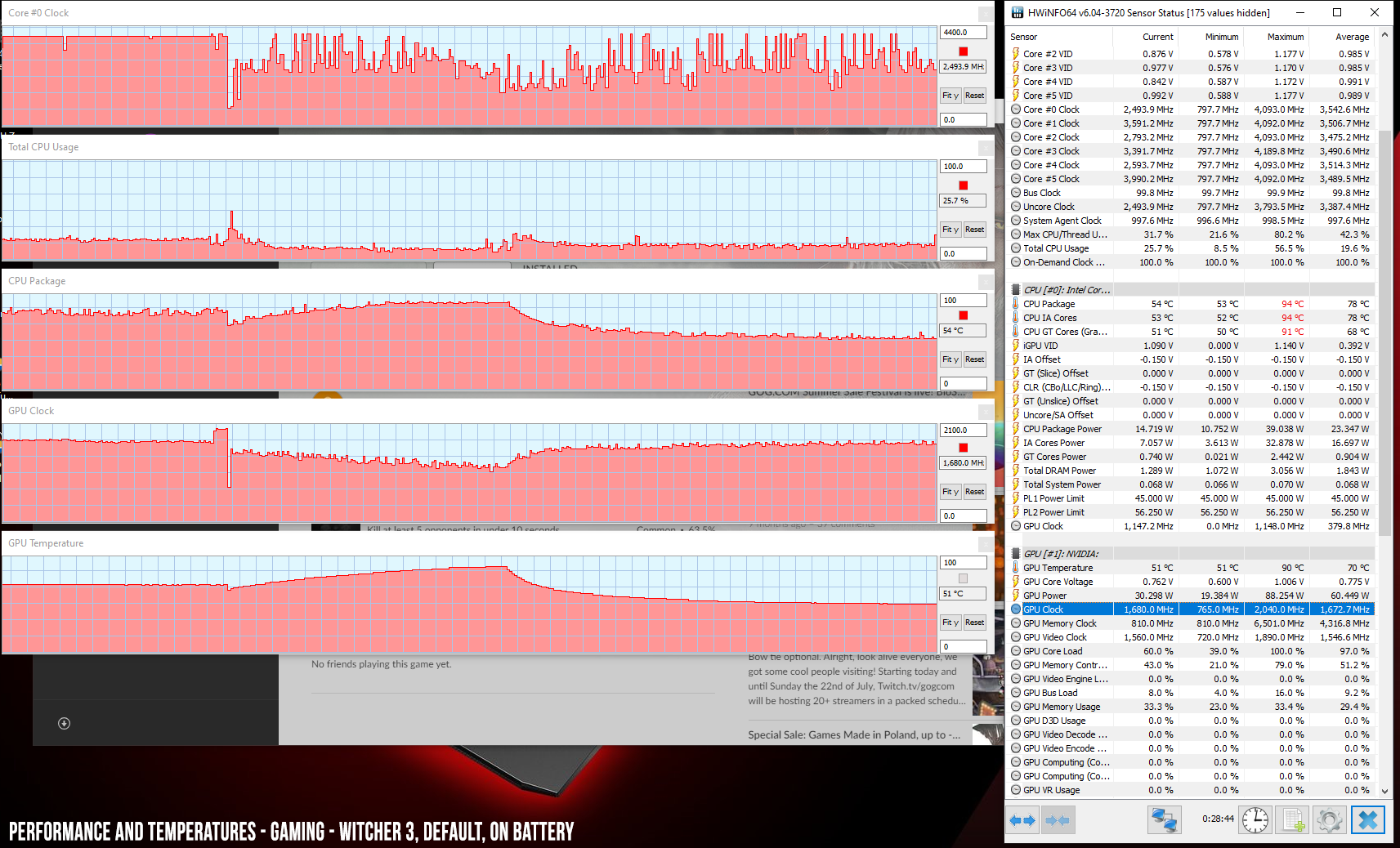
If you don’t want to dig through the logs, this is what we got in Witcher 3:
- Standard profile (fans on Auto, 52-53 dB): CPU: ~3.7 GHz, 91 C; GPU: ~1.6 GHz, 76 C;
- Undervolted CPU + standard GPU (-150 mV undervolted CPU, fans on Auto): CPU: ~3.1 GHz, 76 C; GPU: ~1.68 GHz, 71 C;
- Tweaked profile (-150 mV undervolted CPU, GPU +200 MHz Clock/ +1000 MHz Memory, fans on Auto, still 52-53 dB): CPU: ~3.9 GHz, 82 C; GPU: ~1.76 GHz, 71 C.
All in all, the components on our sample ran hot with out-of-the-box settings, which limited both the CPU and GPU performance.
Undervolting the CPU helps, but the temperatures remain high with demanding games (around 90 C for CPU, 75+ for GPU in FarCry 5, lower in Witcher and Battlefield), and that prevents the GPU from reaching the high frequencies we’ve seen on other GTX 1660Ti implementations with better thermals, like the MSI GL63, which remains the reference among the 1660Ti devices we’ve reviewed so far. Even so, the Nitro 5 is within 5-10% of the MSI in most titles, and mostly on par with the average 1660Ti implementation in the entry-level niche, so the high CPU/GPU temperatures remain the major concerning factor here.
Emissions (noise, heat), Connectivity and speakers
The Nitro 5 gets a fairly basic thermal implementation, with a design we’ve previously seen on many other Acer laptops. Two high-cfm Aeroblade fans are used, as well as three heatpipes that cover both the CPU and the GPU. Acer uses the same design for the 15 and 17-inch models, and as a result, there’s quite a gap between the radiator on the left side and the laptop’s exterior.

As shown in the previous section, this cooling solution shows its limitations on this i7/GTX 1660Ti (80W) configuration, at least based on our experience with our sample. For comparison, the GTX 1650 (50W) Nitro 7 configuration we’ve reviewed earlier kept the CPU/GPU at much cooler temperatures, while also running quieter. Aside from the obvious fact of having to cool a lower power GPU, the metal chassis most likely helped with the heat dissipation on the Nitro 7. As a result, the Nitro 5’s plastic shell doesn’t heat as easily or as much, but the internals run hotter and the fans spin faster and noisier (52-53 dB at head level).
The two fans keep spinning with daily use (movies, browsing, text editing), yet they are pretty much inaudible in a normal environment and you’ll barely notice them in a quiet room. It’s also worth adding that we haven’t noticed any sort of coil whine or electronic creaking on our sample, but that’s not a guarantee you won’t get some with yours.
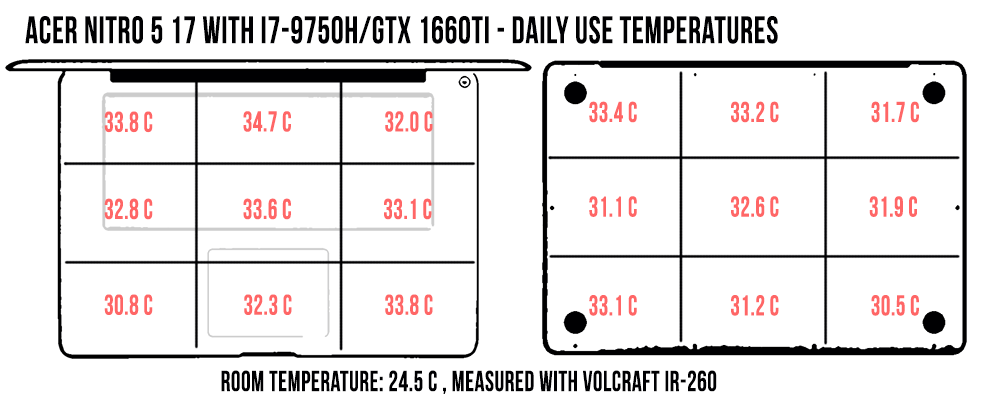
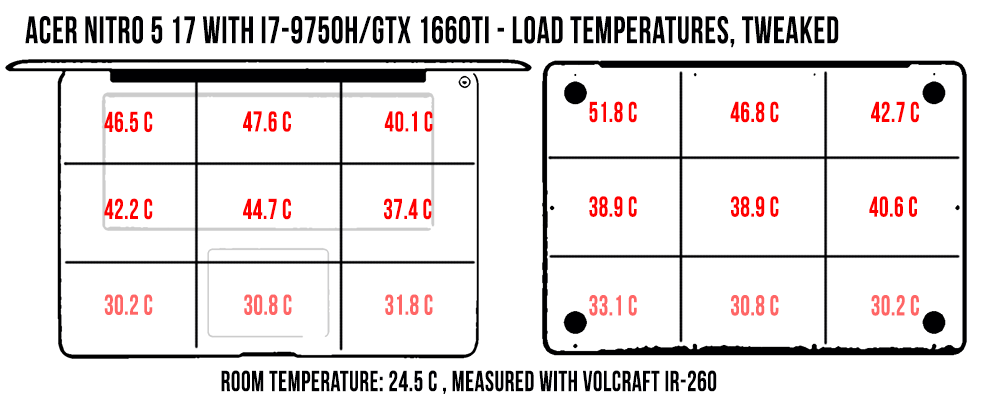
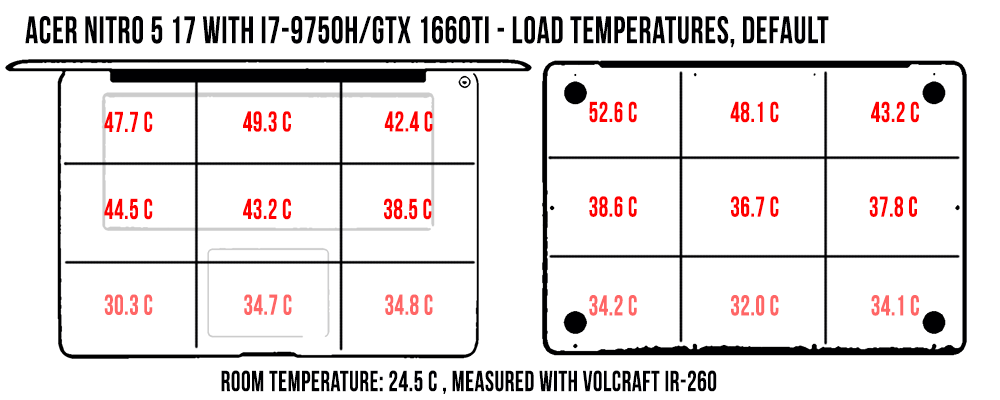
*Daily Use – streaming Netflix in EDGE for 30 minutes, fans on Auto (36-38 dB)
*Load Default– playing Far Cry 5 for 30 minutes, fans on Auto (52-53 dB)
*Load Tweaked– playing Far Cry 5 for 30 minutes, fans on Auto (52-53 dB)
For connectivity, as far as I can tell there’s only a 1×1 Intel 9560 wireless implementation inside this laptop, with Bluetooth 5.0, as well as Gigabit Lan through a Killer E2500 module. We’ve mostly used our sample on wireless, and it performed well both near the router and at 30+ feet away, with obstacles in between, but didn’t reach the high speeds attainable on other laptops, including the Nitro 7.
As far as the speakers go, there’s a set of them firing through small cuts on the lateral sides of the underbelly, and they’re rather poor. We measured maximum volumes of about 78 dB at head-level, without any distortions, but the sound is harsh at maximum volumes, lacking in the mids and the lows. The bass was only noticeable from around 115 Hz, and judging by the tiny size of the actual speaker chambers inside the laptop, the mediocre sound comes as no surprise. I would have actually expected Acer to put some larger speakers on this 17-inch variant, but they stuck to the same modules they’re using on the 15-inch models.
There’s also a 720p webcam on the Nitro 5, placed at the top of the screen and flanked by microphones. It’s grainy and rather washed out, but actually a bit better than what most other OEMs put on their mid-tier laptops these days.
Battery life
There’s a 58 Wh battery inside the Nitro 5, which is not large by today’s standards, but at the same time not bad either for the entry-level gaming segment.
Yes, I complained about its size on the Nitro 7 and Predator Helios 300, as those are higher-tier laptops, and yes, it would have been nice for Acer to put a larger capacity battery inside this larger 17-inch SKU, as there’s plenty of space for it inside, but at the same time this Nitro 5 is also one of the more affordable variants in its niche, and that comes with some understandably required cost cuts.
Here’s what we got on our review unit, with the screen’s brightness set at around 120 nits (~20 brightness).
- 15 W (~3h 45 min of use) – text editing in Google Drive, Better Battery Mode, screen at 20%, Wi-Fi ON;
- 16.4 W (~3h 30 min of use) – 1080p fullscreen video on Youtube in Edge, Better Battery Mode, screen at 20%, Wi-Fi ON;
- 16.3 W (~3 h 30 min of use) – Netflix fullscreen in Edge, Better Battery Mode, screen at 20%, Wi-Fi ON;
- 20.4 W (~3 h of use) – browsing in Edge, Better Performance Mode, screen at 20%, Wi-Fi ON;
- 50 W (~1+ h of use) – Gaming – Shadow of Mordor, Max Performance Mode, screen at 20%, Wi-Fi ON, fps limit of 40.
I’d expect better runtimes with Youtube/Netflix on the final retail units, as well as extra improvements if you go with the 60 Hz screen variants, of around 3.5 hours of daily use and 5 hours of video.
Acer bundles this Nitro 5 configuration with a fairly chunky 180 W power-brick, adequately sized for the hardware inside, though. Lower end GTX 1650 variants ship with a smaller 135W charger.
There’s no quick charging, so the battery fills up in about 2 hours. USB-C charging is not supported.
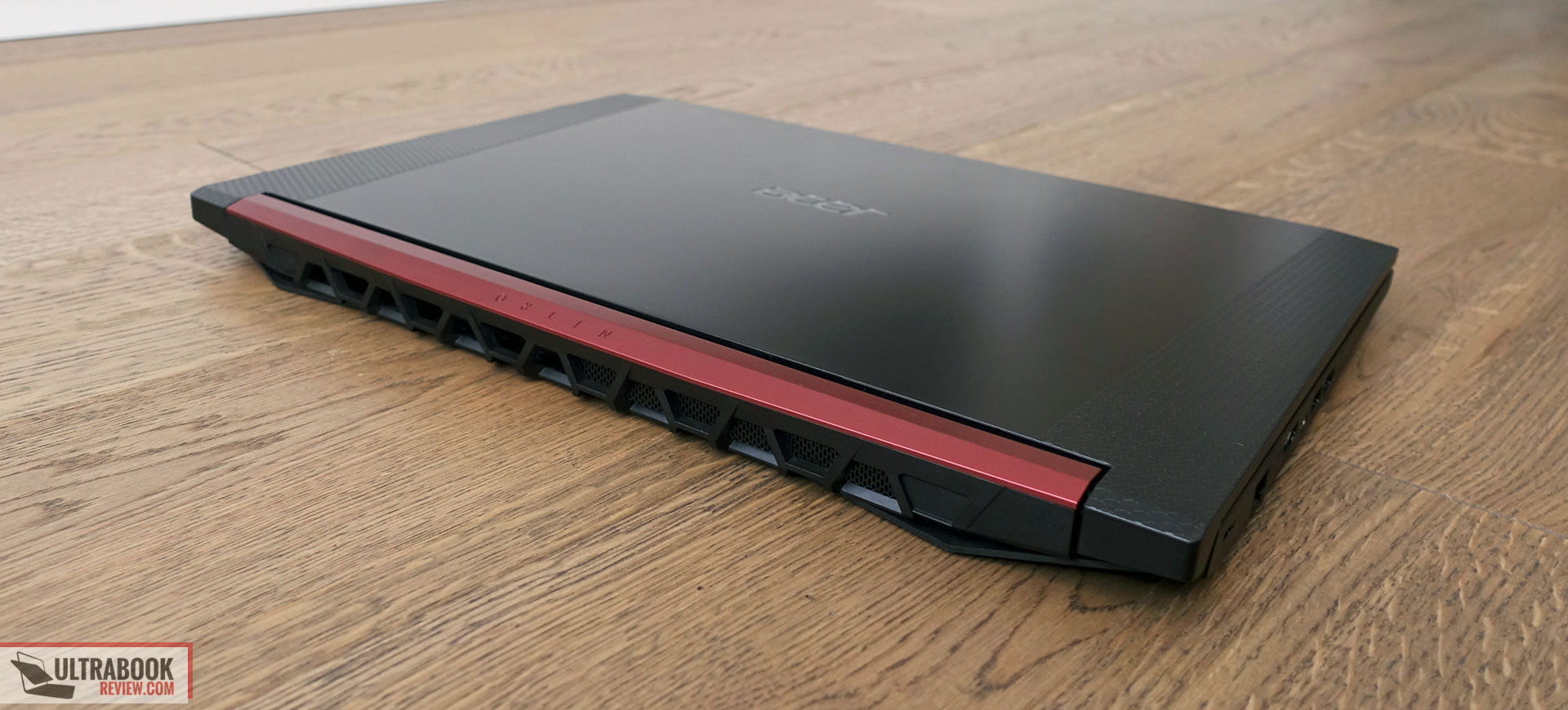
Price and availability
The 17-inch Nitro 5 is available in stores around the world, starting at $879 in the US and 1099 EUR in Europe.
That’s for the base level Core i5-9300H / GTX 1650 models with 8 GB RAM, 256/512 GB SSD and based on region, most likely the 60 Hz screen option. Keep in mind that if you’re getting this with just 8 GB of RAM, you should definitely add another 8 GB stick of RAM to benefit from dual-channel memory in games, it makes a big difference.
The higher-tier GTX 1660Ti configurations are not as widespread for now, but they start at 1299 EUR in Europe.
You can follow this link for updated configurations and prices in your region, at the time you’re reading the article.
Final thoughts
We’re primarily going to draw conclusions on the 17-inch Nitro 5 here, the unit we’ve reviewed, and compare it to the alternatives on the market.
You should also keep in mind that our review unit was pre-production, and although it ran on the latest drivers available as of June 2019, the performance and thermal behavior of the final retail units might be slightly improved, so I’d advise you to look into further detailed reviews if performance is something you’re primarily interested in.
That being said, the 17-inch Nitro 5 AN517-51 is definitely a very competitive option in its class, as one of the most affordable 17-inch laptops with the latest generation Intel and Nvidia platforms. It checks most of the right boxes in the build, IO, keyboard, performance, thermals and battery-life departments, and falls short at internal temperatures on our reviewed configuration, as well as on speaker quality. However, as long as you’re opting for the GTX 1650 models, the thermal module should keep them in check just fine, as hinted by our review of the similarly designed, and smaller, 15-inch Nitro 7. However, you should not forget that this base version comes with a 60 Hz panel, thus slower and overall poorer in quality than the Chi Mei 144 Hz option on our review unit.
The competition includes devices like the affordable Asus TUF FX705 series, with an AMD CPU and Nvidia GPU, the MSI GL73 (17-inch version of the GL63 reviewed here) and the newer GF73, as well as the Lenovo Legion 540 17 or the HP Pavilion Gaming 17, each with their pros and cons. These are more expensive than the Nitro 5 at the time of this review, but you should check them out carefully at the time of your purchase, in order to get the best value product for your needs and budget.
That aside, if you’re primarily interested in a GTX 1660Ti configuration, I would also highly recommend considering the higher-tier 17-inch Acer Predator Helios 300, which comes with a 144 Hz screen by default, an RGB keyboard, a metallic chassis, slightly better speakers and a much improved thermal module.
That pretty much wraps up our review of the 17-inch Acer Nitro 5 AN517-51, but we’re looking for your feedback and impressions down below, in the comments section, so get in touch if you have anything to add or any questions.
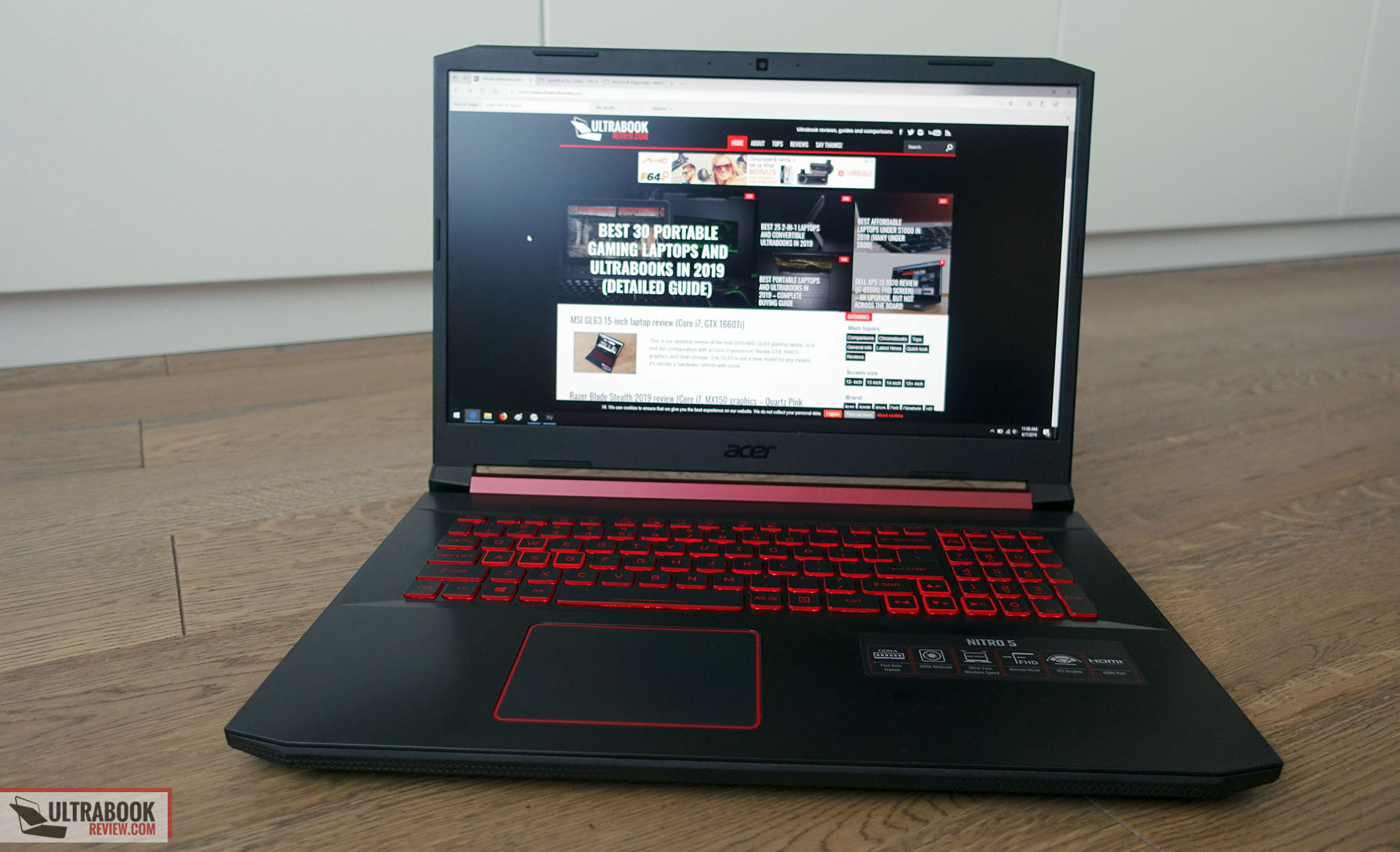
Disclaimer: Our content is reader-supported. If you buy through some of the links on our site, we may earn a commission.
Navigation: Ultrabookreview.com » 15.6 inch or larger
Our content is reader-supported. If you buy through some of the links on our site, we may earn a commission. Terms


Review by: Andrei Girbea
Andrei Girbea, Editor-in-Chief. I’ve a Bachelor’s in Computer Engineering and I’ve been covering mobile technology since the 2000s. You’ll mostly find reviews and thorough guides written by me here on the site, as well as some occasional first-impression articles.
. I’ve a Bachelor’s in Computer Engineering and I’ve been covering mobile technology since the 2000s. You’ll mostly find reviews and thorough guides written by me here on the site, as well as some occasional first-impression articles.






